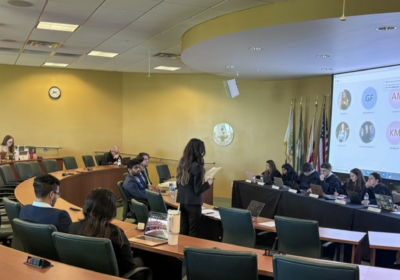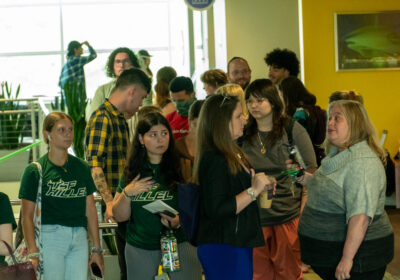A look at the 2016-17 A&S budget

Student Government (SG) recently released the scheduled budget for the $16,871,945 received through the Activity and Service (A&S) fees. With the new budget come shifts in where the money is allocated from year to year.
The SG Activity and Service Fee Recommendation Committee (ASRC) is comprised of 13 members: the student body president, the finance chair, eight elected senators, the chief financial officer and an addition representative from the executive branch.
This past year, it was the former Vice President Michael Malanga who also chaired the committee.
“The committee goes through and critiques budget requests from multiple entities across campus — mostly student affairs departments but there are some expectations — as well as student government and student organizations,” former Student Body President Andy Rodriguez said.
Students pay a $7 flat fee per semester into the A&S fund along with an additional $12.08 per credit hour. The committee trains during fall semester in order to understand the guidelines for allocating funds and then spend Fridays during the spring semester meeting with organizations requesting funding.
The budget is divided into four different subcategories into which each organization falls. The Student Programs and Services, Student Government Operations, Student Organizations, and Interim & Reserve Accounts.
Most A&S fees go into the Student Programs and Services pot, which has currently been allocated $10,819,383. These are organizations such as the Marshall Student Center, the Center for Student Involvement (CSI) and Campus Recreation.
One of the major changes in this year’s budget is that Office of Fraternity and Sorority Life will now be part of CSI, which will receive together $2,049,313.
Another large change is the creation of a Student Oracle Advertising Fund, which sets aside $23,320 that organizations can request from in order to place ads in the Oracle.
By allowing organizations to request funding for ads within their overall budget, the money got mixed in with the rest and often times didn’t end up being used for advertising. The hope is that this budget will allow that money to be used for its intended purpose.
Most of the changes in the Student Government Operations budget are a result of reorganizing things, according to Malanga. For instance, the funding for USF Day at the Capitol is no longer its own account but has been moved to the Executive Branch budget.
The large shifting came between the Executive Branch and the Special Projects budget.
“The Executive Branch is responsible for all the programming that (SG) does, but in years past, they had put the programming money into what we call ‘Special Projects,’” Malanga said.
“Special Projects is meant for contracts — things that we are obligated to do on a contractual basis would go in Special Projects so that the money has no choice but to go to that.”
For instance, free student printing comes from the Special Projects budget where as events such as Day with the Bucs are organized by the Executive Branch of SG. The rebalancing of these accounts has resulted in an increase of $195,430 from last year.
This year, the largest change in the Student Organizations was the creation of Engineering Council. While in years past there’s been a Sports Club Council and a Medical Council, the Senate decided to create a third council.
Councils receive a certain allotment of money from the A&S fees based on the number of organizations within the council, and then are responsible for distributing it among them. While they’re not required to distribute evenly, the system works under the assumption of a fair process.
According to Malanga, the councils are allowed to give one organization more money based on the projects they plan to do as long as if a different organization wanted to do the same projects then it would receive the same amount.
“For example, a lot of them are requesting robotics equipment,” Malanga said. “I’m an accounting major. I knew nothing about that. For me to try to make a decision about that was pretty up in the air about how that was going to happen, it was a guessing game.
“But if you give it to engineering students who actually have some concept of the equipment then they’ll be able to say ‘You’re asking for $100, but you can get it for $10 online’ or ‘You’re asking for $50 for this and that’s exactly what it costs.’ Hopefully that will be a little bit more fair.”
The Interim and Reserve Accounts includes funding for Homecoming and Travel Grants. In the past, it’s also included $15,900 under the title of Signature Events Grants.
According to Malanga, this was originally made to subsidize a large program on campus that had never happened before, but the issue came in that the next year the event wouldn’t be eligible for that funding and the funding stopped being used much.
“The committee talked about starting — hopefully this year — a collaboration grant so that organizations that work together on an event … that would be an event that would count for this new grant fund,” he said. “But in the mean time, we didn’t want to put money into an account that wasn’t working.”
Also included in this subcategory is the Unallocated Reserves account, which holds approximately 10 percent of the total amount of fees collected.
Florida law requires student governments to set aside between five and ten percent to ensure they maintain sound financial condition — for example, in case of a fall in enrollment — and is not intended to be accessed on a regular basis.
“I think it’s the most important thing that (SG) does,” Rodriguez said. “We’re lucky to live in a state where students are empowered to make decisions when it comes to allocating money, and there’s one pot in particular, which is the A&S fund that students are completely in charge of and completely empowered to allocate.”







